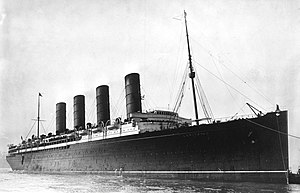Class started with a reminder that homework assignment #2 is due Monday, and due Wednesday a selection from the IEEE archives for the final project.
The anonymous self-written tests from our previous class were discussed, and praised for their depth and insights. We expanded on an answer to “why did Hollerith use punched cards instead of tape”, noting that cards could be resorted and accessed randomly, while tape constrains one to always reading data in a particular order. This is analogous to the difference today between “random access” and “serial access”.
 Next, we went back in time to World War I. In May 1915, the RMS Lusitania, a British merchant ship with many American citizens aboard, was sunk by German U-boats. This was before America had entered World War I. Germany was starting to flex its naval muscles with its U-boat fleet. In 1917, Germany sent the famous Zimmerman Telegram to its ambassador in Mexico, seeking to form an alliance with Mexico. Germany would assist Mexico in reclaiming former Mexican territory including Texas, New Mexico, and Arizona; in return, Mexico would form an alliance with Germany, attacking the United States to prevent them from engaging Germany in Europe. British intelligence intercepted the note during its initial transmission, and it was decoded by their cryptographers. The note was published in American newspapers, purporting that it had been intercepted by spies when the note was in (unencrypted) transmission via telegram across Mexico. The revealing of this information prompted America’s entrance to the war. It wasn’t until 1923 however that Churchill admitted that British cryptographers had in fact intercepted and decoded the message – throughout the war, the Germans had no idea that their private communications were being intercepted.
Next, we went back in time to World War I. In May 1915, the RMS Lusitania, a British merchant ship with many American citizens aboard, was sunk by German U-boats. This was before America had entered World War I. Germany was starting to flex its naval muscles with its U-boat fleet. In 1917, Germany sent the famous Zimmerman Telegram to its ambassador in Mexico, seeking to form an alliance with Mexico. Germany would assist Mexico in reclaiming former Mexican territory including Texas, New Mexico, and Arizona; in return, Mexico would form an alliance with Germany, attacking the United States to prevent them from engaging Germany in Europe. British intelligence intercepted the note during its initial transmission, and it was decoded by their cryptographers. The note was published in American newspapers, purporting that it had been intercepted by spies when the note was in (unencrypted) transmission via telegram across Mexico. The revealing of this information prompted America’s entrance to the war. It wasn’t until 1923 however that Churchill admitted that British cryptographers had in fact intercepted and decoded the message – throughout the war, the Germans had no idea that their private communications were being intercepted.
This dramatic breach of security for the Germans led to the development of the enigma machine. Over 30,000 of the machines were built during the course of World War II. The mechanisms of this machine were the subject of our reading for today, an excerpt from The Code Book.

To get a better sense for how the enigma machine operates, we used paper enigma simulators to decode a secret message on the board: MPXNCZJA. The scramblers were arranged in order of 1-2-3, and the day’s key was MCX. Recall that the first three letters are the message key, leaving NCZJA as the message. Decoding the message and taking it to the honors college office was rewarded with a prize.
We wrapped up our discussion by reflecting on what ultimately led to the failure of the system: not the encryption itself, but its human users. The use of repeated, predictable phrases, easy-to-guess message keys, and other patterns to exploit led to the messages being decrypted far faster than they would have been if better practices had been followed. As with many security systems, the weakest link in the chain of security is not the system itself, but those who must operate it.


I thought that learning about how things were encrypted and decrypted messages was really interesting. Before this class I thought that encryption was just changing letters to different letters, but I didn’t know about the multiple levels of letter changing.
I also found the using of common phrases to decrypt messages was interesting, such as knowing the time Germans sent out a specific message, such as the weather report and knowing that the word weather would be in it and using that to decrypt the message was very smart!